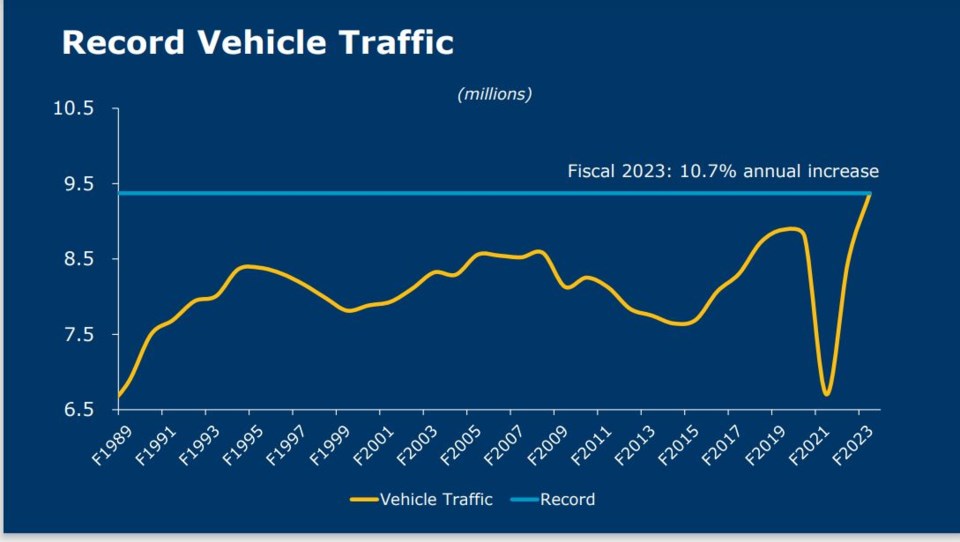Updated Aug. 29 at 9 a.m.
Reductions in vehicle congestion at BC Ferries' (BCF) Horseshoe Bay terminal and more frequent Sunshine Coast sailings starting next summer depend on a decision due Sept. 30 from the province’s Ferry Commission. The commission is to rule on ferry fare increases allowed from April 2024 to March 2028 (Performance Term 6).
Once fare levels are set, the corporation can move forward with proposed operational changes. Those, according to its vice-president of strategy and community engagement, Brian Anderson, include daily supplemental summer season sailings as of 2024 for Route 3 (Langdale/Horseshoe Bay). Services would be added on Tuesdays and Wednesdays, days that went without extra summer sailings in 2023. During BCF’s Annual General Meeting on Aug. 24 he said another part of its PT 6 proposal is “an incremental vessel that would enable two ship service to be not just a summer thing, but a year-round thing” for Route 3. (Permanent assignment of two ships to Route 3 is not addressed in that submission.)
Those statements were part of Anderson's response to a question from Southern Sunshine Coast Ferry Advisory Committee chairperson Diana Mumford. In her inquiry, Mumford noted that there were promises made regarding additional 2023 shoulder season sailings for Route 3 that were not delivered on. She also raised flags about health and safety concerns relating to holding Langdale-bound vehicles above the tollbooth due to traffic congestion in the Horseshoe Bay terminal. When such conditions arise, she said many individuals have been trapped in their cars for hours in mid-summer heat and those arriving without reservations for vehicle travel have been told by terminal staff to “come back later."
“Imagine if this technique were used on busy highways to clear traffic,I doubt it would be tolerated. Yet, it is inflicted on [Sunshine] Coast ferry users, even though those ferries are our road,” she stated.
Anderson called Horseshoe Bay “one of the most difficult terminals to operate” given its narrow configuration and location, with a village on one side and steep rock cliffs on the other and with access that “spills out of an eight-lane highway from one of the most densely populated environments in British Columbia.” He said additional Route 3 sailings during peak demand times would help move vehicles more efficiently through the bottleneck area before the toll booth.
New vision needed: move more people not more vehicles
But BCF’s future focus needs to adjust system-wide, not just on individual routes according to Anderson.
“The answer is to address the underlying problem which is too many vehicles trying to travel in the system, which is going to be a major part of the visioning work that is under way with the province and the partners. The solution is not about moving more and more vehicles. It is about moving more and more people in an efficient way and a safe way and there are going to be a number of facets of investment that are going to be required to make that a reality,” he stated.
In the meeting’s opening remarks, chair of BCF’s board of directors, Joy McPhail made reference to the “visioning process” that she said the corporation would be launching this fall. She shared no specifics but said the goal was that through consultation, for BCF to plan to deliver “quality service for years to come." Citing record levels of nine and a half million vehicles and 26 million passengers carried during BCF’s last annual reporting period, she said, “That kind of growth demands long term planning."
Some who opted for virtual participation rather than travelling to Victoria’s Grand Pacific Hotel to be there in person couldn’t see the presentation screens.
The just under two-hour meeting was brought to a close before all individuals who had questions were given the opportunity to ask them. BCF indicated questions not addressed could be emailed to [email protected] and that written responses would be provided.
Coast Reporter noted at least a handful of the southern Sunshine Coast’s local government elected officials, area industry association representatives and residents among the remote attendees.
The full meeting video will be posted to BCF's YouTube channel "in the next day or two" according to an Aug. 24 email from the corporation's executive director of public affairs, Deborah Marshall.



